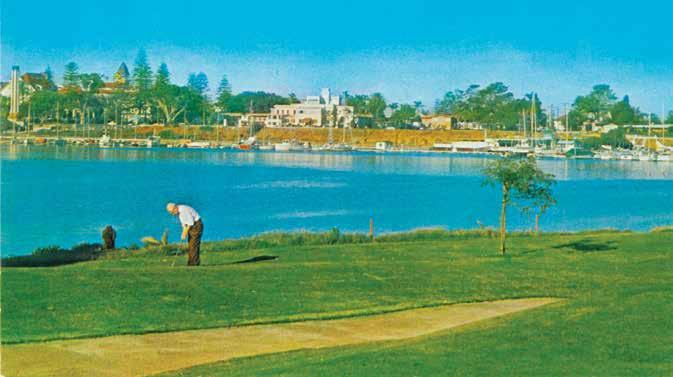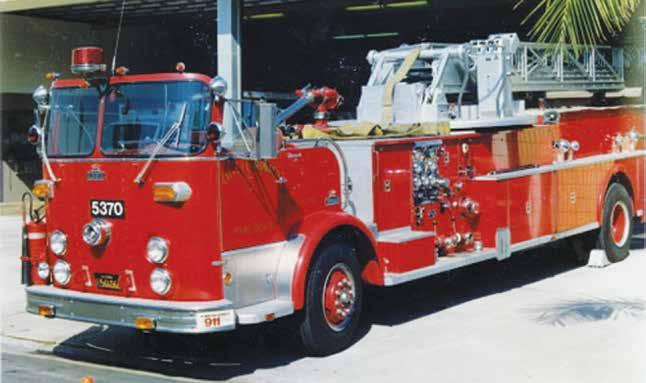
7 minute read
Crown City History
I N C O L L A B O RAT I O N WI T H H OT E L D E L C O RO N A D O & C O RO N A D O H I STO R I CA L A S S O C I AT I O N
Coronado 1969: A Year of Change
Advertisement
B y L E S L I E C R AW F O R D
1969 was a defining year, not only for Coronado, but for the country as a whole. For anyone old enough to remember 1969, it’s hard to recall all the historic events that occurred that year. Coronado, the sleepy little military town, was undergoing one of the biggest shifts ever with the opening of the San Diego-Coronado Bridge and the development that followed. The world was changing, and so was the Crown City. Here is a snapshot of Coronado a half century ago.
Population
• Census records show that a third of the population was under 18 years old, with the average age 25. The total population was 25,500, including officers and enlisted men living on Naval Amphibious Base Coronado, Naval Air Station North Island and on ships. The city of Coronado’s population was about 16,000. Three years old when her family came to Coronado in 1886, Maude Mathewson Messner was thought to be the oldest living resident and property owner.
Development
• The year started with the first traffic light at Orange Avenue and Dana Place. • The San Diego & Arizona Eastern Railway had its final run through the streets of Coronado, halting a service that had been in place since 1888. The last few years, the train had been used to transport supplies to North Island.
• Development was growing dramatically. The city approved an astonishing $12.8 million in construction, compared with $2 million 1968.
ˆCoronado Hospital was under construction and at three stories high, seemed massive. The only other building of that height was the Hotel del Coronado.
• A fresh-water pipeline with a capacity of 10 million gallons per day was laid across San Diego Bay by California American Water to connect City of San Diego sources to Coronado. The new line would supplement the original 8-inch cast iron pipeline, constructed and laid across the bay in 1886. The new pipe was forecast to provide ample water to Coronado until the year 2000. • In May, the new post office was dedicated on Ynez Place. M. Larry Lawrence was the general contractor for the building. Guest speaker Karl Koehler, from the U.S. Postal Service’s regional office in San Francisco, stressed the importance of using the new zip code system to help move the mail more efficiently.
LESLIE CRAWFORD COLLECTION

ˆNegotiations with the Port of San Diego resulted in a 40-year lease of the Coronado Golf Course. A representative of the U.S. Golf Association inspected the course in September 1969 and reported that it is among the finest in the country. • A $67 million development of Del Coronado Sands was announced. It was to be a low-rise apartment complex (four to six stories) with auxiliary facilities at a 37-acre site just south of the Hotel Del. A rock wall would be erected on the ocean side of the property to protect it and create a public beach with access easements. As the year progressed, the project changed dramatically, from the name change to Coronado Shores to the final plans – 15-story-high condominiums designed by architect William Krisel, known for his modernist midcentury designs.
• A new lifeguard tower opened at Central Beach with lifeguards on duty daily during the summer months, and on weekends and holidays the rest of the year. • In September, the Coronado Cays debuted with waterfront living. Ninety-three lots sold for more than $5.5 million in one day.

ˆMilitary housing built in World War II on land that is now Tidelands Park was torn down. Coronado Fire Department used the opportunity to do a controlled burn on one section of the housing for practice, but nearby residents complained of ash and smoke residue, so the rest was demolished. • The Central Liquor store at 2nd Street and Orange Avenue, built in 1890 and one of the city’s oldest buildings, was torn down. It was originally built by the Mathewson family to house Coronado’s first grocery store.
Coronado 1969: A Year of Change
• Plans were presented to the city for the Oakwood Garden Apartments (now known as The Broadstone), a development designed for “young marrieds” and singles.
U.S. Navy
• Before his term ended in January 1969, President Lyndon Johnson awarded the Presidential Unit Citation to Coronado’s SEAL Team One for extraordinary heroism in action against the Viet Cong in the Republic of Vietnam, from July 16, 1966 to Aug. 31, 1967.

• Navy Reworks Facility on North Island turned 50 years old, a milestone for the progress made in naval aviation.
Bridge & Ferries
• Coronado Historical Association was formed in March 1969 in response to the loss of the ferry service with the opening of the bridge. The goal of the organization was to preserve a ferry “as a monument.” A hearty attempt to raise the funds needed to buy one of the ferries fell short.
• In May, the final link of the bridge was put in place, more than two months before the official opening.
• At the stroke of midnight on Aug. 3, 1969, service on the Coronado ferries ceased, ending 83 years of operation and a way of life in Coronado.
• Also at the stroke of midnight, the San DiegoCoronado Bridge opened. It was estimated that over 91,000 cars crossed the bridge in the first 36 hours of operation.
Hotel del Coronado
ˇThe Del’s turret was dressed with yellow and amber lights “to light up the city” all year in celebration of San Diego’s 200th birthday.
• A cat named Adolph belonging to the Anderson family of Coronado, followed his owners to The Del on New Year’s Eve where they attended a party in the Windsor Room. He got lost, taking his own tour of the hotel and was befriended by the telephone operators who heard him meowing outside their door. Adolph ended up having such a good time that the Andersons had a hard time keeping him at home. It was remarked by a hotel employee, “Why anyone with good taste loves The Del!”

• Raquel Welch treated her parents, Mr. & Mrs. Daniel Smith, to a vacation at The Del. › The Del’s famous Luau Room closed, to be replaced by an upscale restaurant called the Prince of Wales Grille. Architect Homer Delawie and interior designer Dixon Morrow comprised the design team with the goal of creating the most superb dining spot in San Diego County.
CORONADO PUBLIC LIBRARY

Odds & Ends
• Mayor and Mrs. Paul Vetter’s house won Coronado Floral Association’s Best Home Front in Coronado.
• Karen Bass was Miss Coronado. CHS senior Kim Kendall was crowned homecoming queen.
• Coronado Unified School District banned skirt lengths more than three inches above the knee.
• Pop Warner Junior League Football was introduced to Coronado.
• The iconic movie Easy Rider was released in July, and Dennis Hopper was spotted eating at the Mexican Village in September.
ˆCoronado Fire Department was allocated $84,000 in the city budget for the first ladder truck to accommodate the proposed high-rises.
• An advertisement in the Coronado Journal listed a three-bedroom, two-bath home near the ocean for rent for $300/month. • Marco’s Pizza hosted its annual Christmas party for all kids 12 and under, serving free pizza, candy and soda.
• By the end of the year, there was public outcry about the traffic flow impacting residential areas. A new Coronado General Plan proposed through 1990 was being formulated, with a recommendation that Coronado’s population be held to a maximum 47,000 people by 1990. (It was 26,663 in 1990 according to the U.S. Census Bureau.)
At the bridge opening ceremonies, Coronado’s Mayor Dr. Paul Vetter was quoted saying, “Coronado will never be the same, but we hope it will not change as a comfortable town.” Change is constant, but it’s safe to say that Coronado is still a comfortable town. What will the next 50 years bring to the Crown City?






